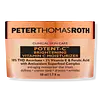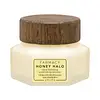What's inside
What's inside
 Key Ingredients
Key Ingredients

 Benefits
Benefits

 Concerns
Concerns

 Ingredients Side-by-side
Ingredients Side-by-side

Water
Skin ConditioningTetrahexyldecyl Ascorbate
AntioxidantPropanediol
SolventC9-12 Alkane
SolventGlycerin
HumectantTocopheryl Acetate
AntioxidantBehenyl Alcohol
EmollientPalmitic Acid
EmollientCetyl Palmitate
EmollientPolyglyceryl-2 Stearate
EmulsifyingStearic Acid
CleansingStearyl Alcohol
EmollientOleic Acid
EmollientSoy Acid
EmollientFerulic Acid
AntimicrobialBrassica Oleracea Acephala Leaf Extract
HumectantOlea Europaea Fruit Extract
BleachingHydrolyzed Collagen
EmollientElastin
Skin ConditioningZingiber Officinale Root Extract
MaskingLactic Acid
BufferingCeramide NP
Skin ConditioningSodium Hyaluronate
HumectantButyrospermum Parkii Butter
Skin ConditioningWheat Amino Acids
Skin ConditioningGlycine Soja Sterols
EmollientSaccharomyces Ferment
Skin ConditioningJojoba Esters
EmollientOlus Oil
EmollientGlyceryl Stearate
EmollientGluconolactone
Skin ConditioningCalcium Gluconate
HumectantSodium Benzoate
MaskingSodium PCA
HumectantSodium Stearoyl Lactylate
EmulsifyingMyristic Acid
CleansingSodium Hydroxide
BufferingSodium Lactate
BufferingLauroyl Lysine
Skin ConditioningArachidic Acid
CleansingLauric Acid
CleansingPotassium Sorbate
PreservativeCoco-Caprylate/Caprate
EmollientSodium Carboxymethyl Beta-Glucan
CleansingHistidine Hcl
Skin ConditioningCarnosine
Skin ConditioningPolyglyceryl-6 Distearate
EmulsifyingArachidyl Alcohol
EmollientCetyl Alcohol
EmollientLauryl Alcohol
EmollientXanthan Gum
EmulsifyingCarbomer
Emulsion StabilisingPolyglyceryl-3 Beeswax
EmulsifyingEthylhexylglycerin
Skin ConditioningDisodium EDTA
Mica
Cosmetic ColorantPhenoxyethanol
PreservativeCI 15985
Cosmetic ColorantCI 19140
Cosmetic ColorantWater, Tetrahexyldecyl Ascorbate, Propanediol, C9-12 Alkane, Glycerin, Tocopheryl Acetate, Behenyl Alcohol, Palmitic Acid, Cetyl Palmitate, Polyglyceryl-2 Stearate, Stearic Acid, Stearyl Alcohol, Oleic Acid, Soy Acid, Ferulic Acid, Brassica Oleracea Acephala Leaf Extract, Olea Europaea Fruit Extract, Hydrolyzed Collagen, Elastin, Zingiber Officinale Root Extract, Lactic Acid, Ceramide NP, Sodium Hyaluronate, Butyrospermum Parkii Butter, Wheat Amino Acids, Glycine Soja Sterols, Saccharomyces Ferment, Jojoba Esters, Olus Oil, Glyceryl Stearate, Gluconolactone, Calcium Gluconate, Sodium Benzoate, Sodium PCA, Sodium Stearoyl Lactylate, Myristic Acid, Sodium Hydroxide, Sodium Lactate, Lauroyl Lysine, Arachidic Acid, Lauric Acid, Potassium Sorbate, Coco-Caprylate/Caprate, Sodium Carboxymethyl Beta-Glucan, Histidine Hcl, Carnosine, Polyglyceryl-6 Distearate, Arachidyl Alcohol, Cetyl Alcohol, Lauryl Alcohol, Xanthan Gum, Carbomer, Polyglyceryl-3 Beeswax, Ethylhexylglycerin, Disodium EDTA, Mica, Phenoxyethanol, CI 15985, CI 19140
Water
Skin ConditioningGlycerin
HumectantButyrospermum Parkii Butter
Skin ConditioningCaprylic/Capric Triglyceride
MaskingC13-15 Alkane
SolventCetearyl Alcohol
EmollientPentaerythrityl Tetraisostearate
Emollient1,2-Hexanediol
Skin ConditioningBis-Diglyceryl Polyacyladipate-1
EmollientDiisostearyl Malate
EmollientXylitylglucoside
HumectantHoney Extract
HumectantBetaine
HumectantPanthenol
Skin ConditioningHydrogenated Rapeseed Oil
EmollientHelianthus Annuus Seed Oil Unsaponifiables
EmollientCeramide NP
Skin ConditioningPropolis Extract
Skin ConditioningRoyal Jelly Extract
Skin ConditioningTocopherol
AntioxidantFicus Carica Fruit Extract
HumectantHippophae Rhamnoides Oil
EmollientGlucose
HumectantBisabolol
MaskingXylitol
HumectantAnhydroxylitol
HumectantCetearyl Glucoside
EmulsifyingTriolein
Skin ConditioningAcrylates/C10-30 Alkyl Acrylate Crosspolymer
Emulsion StabilisingHydroxyethyl Acrylate/Sodium Acryloyldimethyl Taurate Copolymer
Emulsion StabilisingArginine
MaskingAroma
Hydroxyacetophenone
AntioxidantXanthan Gum
EmulsifyingGlyceryl Dioleate
EmollientSodium Dilauramidoglutamide Lysine
HumectantSodium Phytate
Sorbitan Isostearate
EmulsifyingCitric Acid
BufferingPotassium Sorbate
PreservativeSodium Benzoate
MaskingWater, Glycerin, Butyrospermum Parkii Butter, Caprylic/Capric Triglyceride, C13-15 Alkane, Cetearyl Alcohol, Pentaerythrityl Tetraisostearate, 1,2-Hexanediol, Bis-Diglyceryl Polyacyladipate-1, Diisostearyl Malate, Xylitylglucoside, Honey Extract, Betaine, Panthenol, Hydrogenated Rapeseed Oil, Helianthus Annuus Seed Oil Unsaponifiables, Ceramide NP, Propolis Extract, Royal Jelly Extract, Tocopherol, Ficus Carica Fruit Extract, Hippophae Rhamnoides Oil, Glucose, Bisabolol, Xylitol, Anhydroxylitol, Cetearyl Glucoside, Triolein, Acrylates/C10-30 Alkyl Acrylate Crosspolymer, Hydroxyethyl Acrylate/Sodium Acryloyldimethyl Taurate Copolymer, Arginine, Aroma, Hydroxyacetophenone, Xanthan Gum, Glyceryl Dioleate, Sodium Dilauramidoglutamide Lysine, Sodium Phytate, Sorbitan Isostearate, Citric Acid, Potassium Sorbate, Sodium Benzoate
 Reviews
Reviews

Ingredients Explained
These ingredients are found in both products.
Ingredients higher up in an ingredient list are typically present in a larger amount.
This ingredient is also known as shea butter. It is an effective skin hydrator and emollient.
Emollients help soothe and soften your skin. It does this by creating a protective film on your skin. This barrier helps trap moisture and keeps your skin hydrated. Emollients may be effective at treating dry or itchy skin.
Shea butter is rich in antioxidants. Antioxidants help fight free-radicals, or molecules that may harm the body. It is also full of fatty acids including stearic acid and linoleic acid. These acids help replenish the skin and keep skin moisturized.
While Shea Butter has an SPF rating of about 3-4, it is not a sunscreen replacement.
Shea butter may not be fungal acne safe. We recommend speaking with a professional if you have any concerns.
Learn more about Butyrospermum Parkii ButterCeramide NP is a type of ceramide.
Ceramides are intercellular lipids naturally found in our skin that bonds dead skin cells together to create a barrier. They are known for their ability to hold water and thus are a great ingredient for dry skin.
Ceramides are an important building block for our skin barrier. A stronger barrier helps the skin look more firm and hydrated. By bolstering the skin ceramides act as a barrier against irritating ingredients. This can help with inflammation as well.
If you would like to eat ceramides, sweet potatoes contain a small amount.
Read more about other common types of ceramides here:
Ceramide AP
Ceramide EOP
Glycerin is already naturally found in your skin. It helps moisturize and protect your skin.
A study from 2016 found glycerin to be more effective as a humectant than AHAs and hyaluronic acid.
As a humectant, it helps the skin stay hydrated by pulling moisture to your skin. The low molecular weight of glycerin allows it to pull moisture into the deeper layers of your skin.
Hydrated skin improves your skin barrier; Your skin barrier helps protect against irritants and bacteria.
Glycerin has also been found to have antimicrobial and antiviral properties. Due to these properties, glycerin is often used in wound and burn treatments.
In cosmetics, glycerin is usually derived from plants such as soybean or palm. However, it can also be sourced from animals, such as tallow or animal fat.
This ingredient is organic, colorless, odorless, and non-toxic.
Glycerin is the name for this ingredient in American English. British English uses Glycerol/Glycerine.
Learn more about GlycerinPotassium Sorbate is a preservative used to prevent yeast and mold in products. It is commonly found in both cosmetic and food products.
This ingredient comes from potassium salt derived from sorbic acid. Sorbic acid is a natural antibiotic and effective against fungus.
Both potassium sorbate and sorbic acid can be found in baked goods, cheeses, dried meats, dried fruit, ice cream, pickles, wine, yogurt, and more.
You'll often find this ingredient used with other preservatives.
Learn more about Potassium SorbateSodium Benzoate is a preservative. It's used in both cosmetic and food products to inhibit the growth of mold and bacteria. It is typically produced synthetically.
Both the US FDA and EU Health Committee have approved the use of sodium benzoate. In the US, levels of 0.1% (of the total product) are allowed.
Sodium benzoate works as a preservative by inhibiting the growth of bacteria inside of cells. It prevents the cell from fermenting a type of sugar using an enzyme called phosphofructokinase.
It is the salt of benzoic acid. Foods containing sodium benzoate include soda, salad dressings, condiments, fruit juices, wines, and snack foods.
Studies for using ascorbic acid and sodium benzoate in cosmetics are lacking, especially in skincare routines with multiple steps.
We always recommend speaking with a professional, such as a dermatologist, if you have any concerns.
Learn more about Sodium BenzoateWater. It's the most common cosmetic ingredient of all. You'll usually see it at the top of ingredient lists, meaning that it makes up the largest part of the product.
So why is it so popular? Water most often acts as a solvent - this means that it helps dissolve other ingredients into the formulation.
You'll also recognize water as that liquid we all need to stay alive. If you see this, drink a glass of water. Stay hydrated!
Learn more about WaterXanthan gum is used as a stabilizer and thickener within cosmetic products. It helps give products a sticky, thick feeling - preventing them from being too runny.
On the technical side of things, xanthan gum is a polysaccharide - a combination consisting of multiple sugar molecules bonded together.
Xanthan gum is a pretty common and great ingredient. It is a natural, non-toxic, non-irritating ingredient that is also commonly used in food products.
Learn more about Xanthan Gum